New cars come with modern conveniences that are either appreciated or taken for granted, depending on who’s sitting behind the wheel. While these are intended to enhance the driving experience, they can also be misused if the driver isn’t careful.

Rear-view cameras are no longer just found on expensive cars
One of those features is the rear-view camera (sometimes called a reversing or backup camera), which is steadily becoming part of standard equipment on more recent releases. As the name says, this piece of hardware transmits a live video feed of the immediate area behind the vehicle in real time, shown on the dashboard monitor where it can be seen by the driver.
The purpose of a rear-view camera is to reduce the vehicle’s main blind spot at the rear, helping the driver avoid hitting an object or another person while the car is moving in reverse. This is useful not just on vehicles that have a three-box design like sedans and pickups, but on two-box vehicles such as SUVs, especially those with a spare tire mounted at the tailgate.

The reverse camera typically uses a wide-angle lens aimed downward
But while the reverse camera provides an enhanced view of what lies beyond the vehicle’s tail end, should this serve as a substitute for using the side mirrors? Not exactly.
It’s important to note that rear-view cameras are typically pointed at a downward angle, primarily for the driver to see potential obstacles directly behind that are on or close to the ground. These include wheel stoppers, trash cans, and the bumpers on other vehicles. Although these cameras use a wide-angle lens, they still have a limited field of view.

Using the vehicle's side mirrors will complement the feed provided by the rear camera
Due to the orientation of the backup camera, it will still have difficulty with certain blind spots. For instance, the sides of the vehicle can be better seen by the exterior side mirrors. Hazards such as a protruding metal bar aimed straight at the vehicle’s rear glass can also go unnoticed by the camera but can be spotted easily by using the rear-view mirror.
Assuming that your vehicle comes outfitted with a rear-view camera, it still pays to use it in conjunction with the relatively low-tech mirrors instead of relying solely on your electronic eye. You never know when it can save you from having to pay for property damage or bodily injury.
Find more tips for beginner car owners at Philkotse.com.
Recent posts
- proper positioning side mirrors Feb 26, 2021
- reverse camera Philippines Aug 18, 2023
- Backup camera - why it should be on your must-buy accessories list? Aug 18, 2023
- Tips with reverse camera: Save your life and enjoy your ride! Aug 16, 2022
- How to adjust rear-view mirrors for a safe drive Jul 06, 2018












